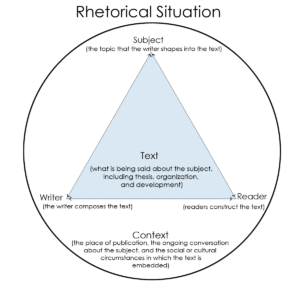Why summary is important
Summary is a task that you’ll encounter often in research-based writing–as an author, you’ll need to explain the essence of a text that you have worked with in developing your own ideas. Writing an effective summary means offering your reader a genuine understanding of the text, not just a list of its greatest hits. Your reader needs a little context–
- what is this text?
- what is the author doing in it?
- what are the key ideas we should take from it?
- and then what are you going to do with it?
Because you’ll need this skill regularly, we’re going to practice and use it regularly–we develop writing skills just like any other kind of competency, through examining models, trying it out, and repeating the drill.
You’ll find a handout on Blackboard that offers some more explanation of writing effective summaries. It’s also linked here: Handout on summary
Let’s think about this in terms of the Herring article you just read for last week. If you were going to explain this article to someone else, it wouldn’t be enough to say that Gundemir and her colleagues talk about some of the pros and cons of workplace diversity. We wouldn’t know anything about who Gundemir is and why we should take her word for it. We wouldn’t know whether this article was grounded in good research. We wouldn’t know whether the idea that there are more fruitful and less fruitful ways to frame diversity is central to her argument, or a kind of tertiary point that she mentions. We wouldn’t understand what the article is.
A summary like this, however, would offer us a lot more value: In his article…. from the Journal of Leadership and Organizational Studies, Seval Gundemir, an organizational psychologist at the University of Amsterdam, examines how companies’ diversity policies affect the way that minority employees view their own leadership potential within their companies. She reports data from 2 different studies that she and her colleagues conducted. She finds that…..
Notice what that summary does–it offers a quick biographical blurb about the author (which tells us that she’s an academic), lets us know that this is a scholarly article (written by a scholar for other scholars in the field), gives us a window into her data set and methods, and then lets us know what she’s arguing. If we know all that, then anything else that you share with us from the article will be a lot more meaningful. We’ll get why it matters and what evidence there is to back it up.
Because effective summary is so essential to writing about research, we’ll be practicing this skill quite a bit in the weeks to come.
Why it’s important to think about genre
This is a term we’ll use quite a bit throughout the course, so it’s worth taking some time to discuss what it means. We often think about genre in relation to music or movies, where we’re accustomed to using it to refer to different ‘types’ of media. These genre labels communicate something to consumers, shape expectations for what that media will be like, and serve as handing sorting mechanisms for us (what we like, what we don’t, what we’re in the mood for, how we would describe something to another person, etc.)
When it comes to genres of writing, that same sort of understanding applies, but it’s worth pushing beyond this simplistic idea of ‘categories’ (as though they’re just sorting buckets) to understand how and why genres take shape.

For starters, genres tend to responses to recurring writing situations–in other words, the same kind of need keeps popping up and we can use the same sort of text to meet that need. Let’s think about applying for a job. That’s a recurring situation, right? Lots of people find themselves having to do that. And there are ways that writing can help to make that situation work. Now, job application materials–resumes and cover letters–didn’t just emerge spontaneously. They took shape because readers and writers found them to be useful ways of meeting that situational need–front-loaded documents that quickly communicate a job seeker’s qualifications, skills, and experiences. AND they’ve taken the fairly standard form that they do (consistent across many decades) because that pretty standard approach to organizing and formatting makes it possible for the reader to plow through a whole bunch of these documents pretty quickly, while still finding what they need.
Thus, we can think about genres as responsive and organic–developed to meet the needs of writers and readers and changeable depending upon circumstances. They’re not fixed, not static, and not simply interchangeable. We need to match genre to situation–thinking about our readers, about our purposes, about our publication/delivery venues.
Everything you do as a writer is a choice. And our choices are shaped by the situations in/for which we write. This rhetorical situation consists of a few key components, illustrated in the diagram below:

Understanding the rhetorical situation of texts helps us as readers understand what to expect from them and how to read them. And for us as writers, understanding our audience and purpose will help us to craft texts that work for our readers, meeting their needs and expectations and providing them a clear path to understanding.
The texts that you’re reading this week come from 2 rather different genres–Gundemir’s article is a fairly typical scholarly text, written by academics for an audience of other academics in their field and providing the sort of intensive research and analysis those readers demand. The other text by Austin & Pisano is from the Harvard Business Review, a publication with a much broader audience of professionals. They turn to HBR for quick insights into topics they might be interested in and are generally not looking for the same kind of deep-dive. When you know what you’re looking at, it’s much easier to navigate through it.
Now, because most of us are not organizational psychologists (I presume), Gundemir’s text isn’t really designed for us. We have to make our own path through it. There’s a handout on Blackboard (also linked here: Handout on Reading Scholarly Articles ) on how to wade through sometimes dense scholarly articles like this one.


